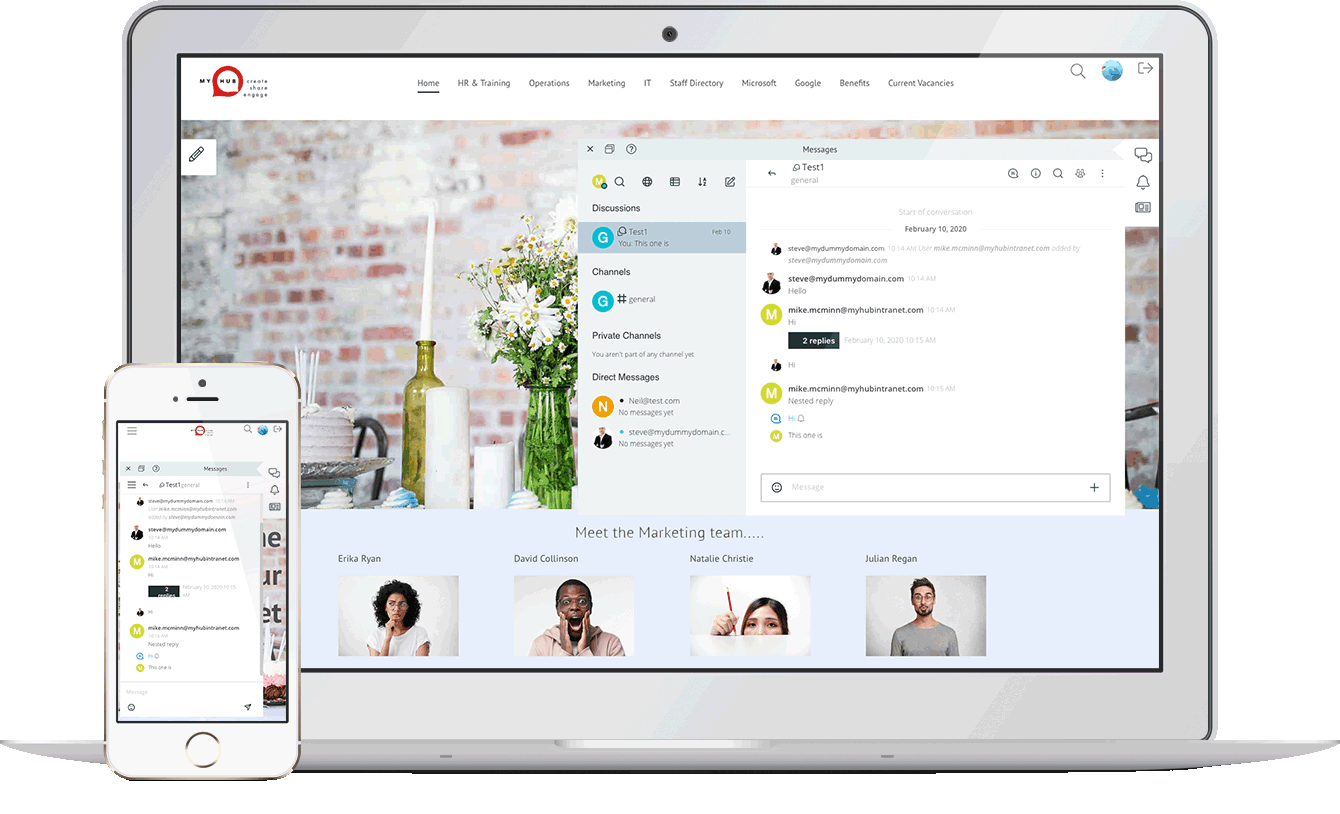Team Collaboration
How To Help Staff Connect, Encourage Ideas, And Move Work Forward
Share. Communicate. Innovate

Team collaboration is a prominent trait among today’s winning organizations. Done right, collaboration aids better decision-making, innovative thinking and improved productivity. Staff are happier, performance is boosted, and there’s less risk of error.
But many organizations have yet to figure out how to help colleagues work better together to achieve a common goal.
The good news is that there are tools and techniques that have proven to nurture a strong collaborative culture within the workplace.
Here, we shed light on the causes of poor collaboration, tips for improvement, and collaboration software that enables co-workers to share ideas and improve internal communications.
What Is Team Collaboration?

The definition of team collaboration is when two or more people work together to achieve a common goal. This is done through idea sharing, planning and executing in unison. In contrast to working on one’s own, team collaboration is regarded as a more productive way to get work done, and carries less risk.
Tackling a major project – such as a new product launch or the introduction of a new internal process – usually requires a teamwork approach. This entails bringing together a group of employees to allocate and complete tasks, within a set timeframe.
These days, with technology overcoming geographical barriers, virtual teams are popular. Companies are now appointing the best people for a project – regardless of their work location – to form part of a team and collaborate. This development has created new opportunities for businesses to innovate – but is not without its challenges.
Why Is Team Collaboration Critical In The 21st Century?

Never before has the workplace been so diverse. For the first time in history, five generations are working side-by-side. Each employee has a unique perspective. Their opinions are formed by their own personal experiences. And they have different communication styles – some prefer face-to-face, others the written word.
Such differences are a lot to manage, particularly when complex, project-based decisions must be made.
How a team interacts with each other will influence the final outcome. Communication, knowledge transfer and equal respect for each team member are essential for a high-performing team.
Younger generations joining the workforce are eager to further develop the collaborative skills they’ve learnt during education. They place place greater support on social tools for collaboration than their older colleagues (49 per cent millennials vs 31 per cent baby boomers). And considering that 46 per cent of 2020’s workforce are millennials (compared with 36 per cent six years ago), employers must act upon this growing generation’s preference for building team dynamics.
Furthermore, around 75% of employees now rate teamwork and collaboration as crucial to their performance.
Reasons For Poor Team Collaboration
It’s a common scenario when a collection of people come together to solve a problem, cross-functionally. There may be representatives in the room from IT, Sales, Product and Finance.
When collaboration fails, it’s often because these individuals partially listen to others points-of-view, but do not fully seek to understand what they were actually saying.
Each representative remains in their own paradigm rather than genuinely taking on board and seeking a solution based on other perspectives.
To counter this, effective collaboration requires recognition of diversity; that each individual has their own thought process and purpose. This requires greater understanding of the team individuals, and the concerns they may be feeling.
These could include the following:
- Skepticism about the success of the project i.e.‘doomed to fail’
- Uncertainty around who does what in the team, and where tasks and responsibilities sit
- Misinterpretation or miscommunication: wrongly assuming all staff have the same understanding
- Lack of direction, KPIs and milestones set out from the start
- Conflicting priorities: failing to appreciate an employee’s current workload before adding more
- Forcing staff to communicate in ways that may be uncomfortable for them i.e. introverted employees making team presentations
How To Improve Team Collaboration
Successful team collaboration is hard work. With so much to consider – silos, company culture, staff at different locations, leadership styles – good team collaboration doesn’t happen by accident.
Furthermore, Harvard Business Review has exposed an interesting paradox at play, based on its research into team behavior:
“Although teams that are large, virtual, diverse, and composed of highly educated specialists are increasingly crucial with challenging projects, those same four characteristics make it hard for teams to get anything done.
“To put it another way, the qualities required for success are the same qualities that undermine success. Members of complex teams are less likely to share knowledge freely, to learn from one another, to shift workloads flexibly to break up unexpected bottlenecks, to help one another complete jobs and meet deadlines, and to share resources.”
It also found that the higher the educational level of the team member, the more challenging collaboration appears for them.
But there are some best practices for building effective collaboration strategies, as follows:
Define And Repeatedly Communicate The Team’s Goals
This is the first step to bringing together a group of people. Goals should be reiterated at the start of daily huddles, referred to when key decisions are underway, and repeated across all communication channels (your intranet, for example).
Promote Open Communication Particularly When Faced With A Roadblock
This is where technology has become a game-changer. Instead of waiting for the next round-table meeting to overcome a roadblock, intranet tools such as forums, instant messaging, and shared files allow members of the same team to work through a problem collaboratively at pace.
Create Structure Within Meetings And Give Staff Time To Prepare
WIP (work-in-progress) meetings are an important part of effective project management. Ahead of each meeting, share agenda items, action lists and related reading material with all members of the team so there are no frustrating delays when teams meet.
Encourage Creativity And Free-thinking: All Ideas To Be Respected
Brainstorming sessions can be fun and fruitful. Team leaders must give advance warning though so staff can do their own research. And if you’re the manager, resist the urge to direct and jump in immediately with your ideas, as staff may feel obliged to follow.
Log Important Decisions And Their Backstory
Avoid the “he said/she said” nature of spontaneous conversations; make sure ideas are contextually documented in a central space, accessible for all, and not lost in the moment.
Invest in Collaboration Tools
Team collaboration tools have shown the way here. Employees can set up team channels where decisions can be made in real-time. Slack, the popular chat tool, has been joined by a host of other instant messaging tools, virtually eliminating the need for traditional email. Video conferencing, in the wake of Covid-19, has become the default meeting format. And forums are another effective channel for effective team collaboration.
Check For Understanding
Nodding heads does not necessarily mean agreement and understanding. Many co-workers won’t like to admit they don’t understand something. Reiterate major decisions – during and after meetings – providing clarity and an opportunity for others to ask further questions. Engage in two-way communication with all members when possible.
Create Ways For Less Outspoken Team Members To Contribute Ideas
Not everyone has public speaking skills. Shy people will not feel comfortable sharing their idea in a room full of colleagues, but may happily submit an idea via a forum or chat channel. Make it known that individual thinking is unique and valued, and that every team member should be able to communicate with equality and authority.
Share Experience, Knowledge And Resources
Use an intranet to capture treasured insights – physically and virtually with file-sharing software. This will save mistakes being repeated, and knowledge walking out the door when someone leaves. Don’t leave this to chance: embed a process for eliciting and storing this valuable intelligence as part of your regular WIP meetings. Add tags to meeting notes that can be searched for later on.
Acknowledge And Celebrate Individual And Team Success
Highlight individual qualities and the special skills that each team member brings to the table. Go big when a milestone or key task has been ticked off with a team building celebration event. This boosts morale and makes people feel valued.
Appoint Task And Relationship-Oriented Leaders
HBR research found that the most productive and innovative teams had leaders who could outline clear goals and responsibilities and easily switch to relationship-building mode i.e. smoothing out internal tensions.
Limit Group Sizes
Not always possible – particularly if you’re about to organize the next Olympics – but aim to keep teams small enough so that staff get to know (and respect) each other, and ideas exchange freely. Big teams tend to be more vulnerable to tunnel vision, or the ‘squeakiest wheel wins’.
❝
Collaborative teams are 5 x higher performing as they feel motivated towards a common goal
Source: i4cp
Team Collaboration Trends
Team Collaboration tools are evolving to suit the changing needs of businesses today.
Flexibility, scalability, and compatibility with existing systems increasingly matter. Because of this, enterprise players such as Cisco, Slack and Microsoft have no choice but to integrate with each other.
Some other noticeable trends in team collaboration include:
Artificial Intelligence
Machine learning tools and bots can help an entire team improve the way they collaborate by making it easier to find information instantly. They can also offer things like real-time translation and transcribing during video conferencing meetings.
Unique Experiences
As more technology vendors come to the integration and interoperability party, open-source platforms with the help of APIs are enabling employers to build their own collaboration experience, just right for their internal culture.
Love Of Video
This format’s popularity continues to rise, but so do expectations around its performance. With remote teams the new normal, businesses are relying more on video conferencing, which must be reliable, secure and consistent.
Team Collaboration Software
Creating a workplace using team collaboration software is a practical move that can really transform how you and your colleagues collaborate.
MyHub’s cloud-based intranet is designed specifically for organizations in search of an affordable and adaptable collaboration solution. It’s fully scalable, designed to support your company’s growth. And fully customizable, to meet your exact needs.
Combining a company internal newsfeed, instant messaging and secure cloud storage, MyHub is the perfect choice for your important projects-in-progress.

Whether you’re an IT pro or completely non-technical, MyHub’s cloud-hosted solution offers all the features and functionality you’ll ever need.
We’ve made it so that it’s super simple to set-up (no coding skills or IT experience required) – and is enjoyable to use!
Using simple drag-and-drop functionality, you can create a professional space for your team to start collaborating in minutes! Being cloud-hosted also means you’re future-proofing your investment: you get to benefit from our latest new features and enhancements as soon as they’re released.
Useful Team Collaboration Resources
Google Intranet: Unleash The Power Of Google Workspace In Your Intranet
Google Workspace has evolved into a staple for businesses of all sizes, providing cloud-based tools like Gmail, Google Docs, Sheets, Slides, Calendar, and Google Drive. These tools offer real-time collaboration, easy sharing, and ubiquitous access. When combined with a modern intranet, Google Workspace becomes even more powerful—bringing together document editing, communication, workflows, and collaboration in a unified platform.
MyHub’s Google-intranet model allows embedding Google documents (Docs, Sheets, etc.) directly within the intranet, meaning users don’t need to toggle between multiple apps. Permissions and document updates are managed in real time, ensuring everyone is always working from the latest version. This integration also supports single sign-on and unified access—reducing login fatigue and improving usability.
The benefits are broad: more efficient internal communication (news, forms, alerts), increased employee engagement through simplified workflows, better knowledge management by centralizing files and context, and cost savings from reduced tool overlap. MyHub also highlights that using Google Workspace together with their intranet increases scalability, reliability (cloud backups), automatic updates, and flexibility for hybrid-or remote work.
Custom Intranet: The 5 Best Intranet Builder For 2025
A custom intranet allows organizations to go beyond basic out-of-box solutions by tailoring features, branding, layout, and integrations to their own needs. Unlike generic intranets, custom ones support specialized workflows, employee engagement, and knowledge management in ways that align closely with the organization’s culture and goals.
The article lists 5 top intranet builder solutions for 2025—platforms that offer drag-and-drop design, strong theming and branding options, integrations with tools like Microsoft 365 or Google Workspace, mobile support, news feeds, collaboration tools, and search functionality. These builders vary in price, flexibility, and level of vendor support.
It also provides guidance for choosing the right custom intranet: assessing business needs, listing “must-have” versus “nice-to-have” features, evaluating usability, vendor reputation, scalability, cost models, and customization ability. The goal is to pick a platform that balances flexibility with ease of use.
Good Organizational Skills: 10 Strong Key Skills You Need
Strong organizational skills are essential in a fast-moving work environment where tasks, meetings, and digital clutter can easily overwhelm. The article highlights 10 key improvements—including keeping a clean, distraction-free workspace, using technology and digital tools, planning schedules, and adopting time-blocking methods—to help you stay focused and efficient.
It emphasizes using tools like digital calendars, reminders, to-do lists, and project management software (or intranet workflows) to manage tasks across different platforms. Prioritizing what needs to be done each day or week, and reorganizing as needed, helps maintain control and reduces stress over missed deadlines or overlapping commitments.
Beyond tools and systems, the post also points out the importance of reward, rest, and balance. Small celebrations of achievements, working in balanced blocks, minimizing distractions, and ensuring downtime are all part of sustaining and growing strong organizational skills over time.
SaaS Intranet Platform for Streamlined Communication And Collaboration
A SaaS intranet is a cloud-based intranet platform provided over the internet rather than hosted on-premises. It removes the burden of infrastructure setup, server maintenance, and software development for companies, letting them focus instead on using the intranet’s capabilities—communication, knowledge sharing, and collaboration—from day one.
These platforms offer numerous benefits including rapid deployment—thanks to out-of-the-box templates and drag-and-drop setup—scalability that grows with the business, robust security managed by the provider, and automatic updates that ensure the intranet stays current without manual intervention. Access is global, whether via desktop or mobile, which makes SaaS intranets especially valuable for remote or distributed teams.
Key features to look for in a SaaS intranet include intuitive ease of use, strong integration with existing tools (CRMs, Microsoft 365, Google Workspace, etc.), mobile accessibility, advanced search, analytics for tracking engagement, and collaboration tools such as instant messaging, news feeds, and employee profiles. To pick the right solution, organizations should assess their needs, security requirements, pricing models, and vendor support.
Enterprise Intranet Software: Use Cases, Examples, Solutions
An enterprise intranet is more than just an internal website—it’s a full digital workplace platform designed for large or distributed organizations. Modern enterprise intranets support internal communication, collaboration, knowledge sharing, and employee engagement from a central, secured location. With remote work now standard and many employees operating outside traditional offices, mobile access and ease of use are critical.
To deliver value, there are several must-have features: communication tools like newsfeeds and instant messaging; social features such as employee profiles, @mentions, and activity walls; collaboration spaces for projects; real-time analytics to track usage and engagement; unified, advanced search; seamless integrations with tools like Microsoft 365 or Google Workspace; and strong security protocols.
The platform should serve both office-based and desk-less workers, ensuring everyone can access relevant content wherever they are.
MyHub includes several real-world case studies showing enterprise intranets in action. For example, Idaho Lottery uses it so field and remote staff can access reports, change requests, and social features easily via mobile. Best Western Hotels’ Scandinavian arm streamlined collaboration across many hotel sites with centralized document access, mobile-friendly interfaces, and better internal communication. These examples illustrate how enterprise intranets aren’t just about having tools—they’re about making them usable, accessible, and embedded in daily work.
Employee Intranet: 42 Hot Reasons Why Every Business Needs One
An employee intranet is a secure, private network for a company’s employees, acting as a central hub for internal communication, collaboration, and access to tools and resources. MyHub explains that it can be used for everyday tasks like expense claims and meeting room booking, as well as more complex needs like cross-team collaboration, knowledge sharing, and streamlined operations.
The article contrasts building an intranet yourself (on WordPress, SharePoint, etc.) with using a cloud-hosted intranet provider. DIY options can offer customization but often require extra plug-ins, technical effort, and long setup time. In contrast, cloud intranet services use pre-built templates, are quicker to deploy, typically have fixed pricing, and need less technical overhead.
MyHub lists 42 reasons why a business needs an employee intranet. Some of the key advantages include enhancing internal communication, making leadership more accessible (e.g. through CEO blogs), facilitating feedback via surveys and quizzes, improving knowledge management, enabling mobile access so that remote, on-the-road, or deskless workers stay informed, automating workflows, improving discoverability via search, supporting onboarding and offboarding, boosting employee engagement, and reinforcing company culture.






